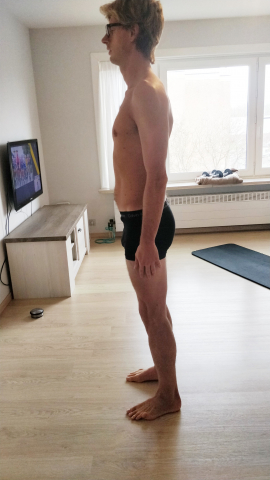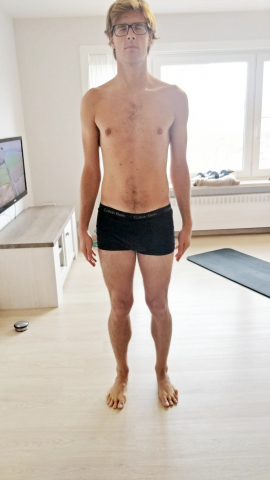Hello,
I attached a few pictures of my posture and also the posture analysis of one of my friends (PT). He thinks I should focus on fixing the anterior tilt first, before I try to start with the Gokhale method. My question now is: Do I really have anterior pelvic tilt? Or is it more a sway back? I find it very hard to see the difference between those.
I already started with a few aspects of the Gokhale method and for me the stretchsitting and (side)stretchlying give me the most relief. I also have to admit that for these pictures, I didn't focus on the Gokhale standing "principles": I just closed my eyes, march in place and then took a picture. I thought this would give me the most accurate image of my posture.
I'd love to hear your opinion. I used to have a lot of back/pelvic pain and my sedentary lifestyle contributes a lot to that, so that's about the first thing I want to change for myself.





3 years 9 months ago
09/07/2020 - 12:33am
No one ?
7 min 12 sec ago
08/20/2010 - 8:19pm
Hi Bjornv,
You did the right thing in sending an unposed photo of your posture:-) Your friend is correct in noting an anterior drift in your standing posture. Standing with your weight forward on your feet contributes to this - you want to bring your weight back over your heels in standing. That will reduce the need to hold tension along the back of your body, including what I would imagine is a sway in the lumbar back - I can't see as your elbow covers the area, but the rounding in your upper back would confirm that pattern.
We use the term 'pelvic anteversion' to describe a healthy forward angle for the pelvis which occurs at the base of the lumbar sacral junction. This is very different from an anterior tilt that follows from an exaggerated curve in the lumbar spine, i.e., a sway. This is explained in detail in Lesson 3 of Esther's book, '8 Steps to a Pain-free Back', but we would recommend that you start with lengthening your lumbar area first in stretchsitting and stretchlying. These lessons (L1 and L2) will also be helpful in reducing your neck curvature and forward head carriage. So, a whole-body approach, following a tried and tested sequence.